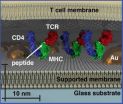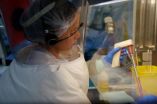(Press-News.org) WASHINGTON D.C., April 22, 2014 -- A team of researchers in Japan has developed a solid-state lamp that emits high-energy ultraviolet (UV) light at the shortest wavelengths ever recorded for such a device, from 140 to 220 nanometers. This is within the range of vacuum-UV light -- so named because while light of that energy can propagate in a vacuum, it is quickly absorbed by oxygen in the air.
This fact makes vacuum UV light extremely useful for industrial applications from sterilizing medical devices to cleaning semiconductor substrates because when it strikes oxygen-containing molecules on a surface, it generates highly reactive oxygen radicals, which can completely destroy any microbes contaminating that surface.
Existing commercial vacuum UV lamps are bulky and expensive, however. They also use a lot of power, run hot, have short lifetimes and contain toxic gasses that can pollute the environment and harm people. The new lamp avoids those issues because it was fabricated with a solid-state phosphor made from a thin film of KMgF3, which is easy to make, avoids the use of toxic gasses and does not require expensive rare earth elements.
In AIP Publishing's journal APL-Materials, the Japanese team describes how this solid-state phosphor promises to make future, low-power vacuum UV lamps that will be more flexible in design as well as being smaller, longer lasting and relatively heat-free -- all traits that are typical advantages of solid state lighting in general.
"Our lamp is a promising light source in terms of lifetime, size, heat conduction and stability," said Shingo Ono of the Nagoya Institute of Technology in Japan, who led the research. "[It] has the potential to be an excellent alternate light source to low-pressure mercury lamps, excimer lamps and deuterium lamps."
In addition to Ono and his colleagues at Nagoya Institute of Technology, the team was comprised of researchers from Universiti Teknologi Malaysia; the Tokuyama Corporation in Tokyo; Tohoku University in Sendai, Japan; and the Kyushu Institute of Technology in Kitakyushu, Japan.
One of the hurdles they faced was to safely fabricate the phosphor using a compound containing fluoride, which is itself a toxic, corrosive and potentially dangerous chemical to handle. One way would have been to use an inflow of gaseous fluoride to coat the surface of the KMgF3 thin film, but instead the team discovered a safer route to fabricating it with pulsed laser deposition -- a way of layering thin films of chemicals onto surfaces through irradiation with a focused laser beam.
INFORMATION:
The article, "Vacuum ultraviolet field emission lamp utilizing KMgF3 thin film phosphor" is authored by Masahiro Yanagihara, Zamri Yusop, Masaki Tanemura, Shingo Ono, Tomohito Nagami, Kentaro Fukuda, Toshihisa Suyama, Yuui Yokota, Takayuki Yanagida and Akira Yoshikawa. It will be published in the journal APL-Materials on April 22, 2014 (DOI: 10.1063/1.4871915). After that date, it may be accessed at: http://scitation.aip.org/content/aip/journal/apm/2/4/10.1063/1.4871915
ABOUT THE JOURNAL
APL-Materials is a new open access journal featuring original research on significant topical issues within the field of materials science. See: http://aplmaterials.aip.org
Vacuum ultraviolet lamp of the future created in Japan
First solid-state vacuum UV phosphor, described in APL-Materials, promises smaller, safer, longer lasting, low power lamps for industrial applications
2014-04-22
ELSE PRESS RELEASES FROM THIS DATE:
Applying math to biology: Software identifies disease-causing mutations in undiagnosed illnesses
2014-04-22
(SALT LAKE CITY)–A computational tool developed at the University of Utah (U of U) has successfully identified diseases with unknown gene mutations in three separate cases, U of U researchers and their colleagues report in a new study in The American Journal of Human Genetics. The software, Phevor (Phenotype Driven Variant Ontological Re-ranking tool), identifies undiagnosed illnesses and unknown gene mutations by analyzing the exomes, or areas of DNA where proteins that code for genes are made, in individual patients and small families.
Sequencing the genomes of individuals ...
New electric fish genus and species discovered in Brazil's Rio Negro
2014-04-22
AMHERST, Mass. – Scientists at the University of Massachusetts Amherst and the Instituto Nacional de Pesquisas da Amazônia (INPA), Brazil, this week report that they have discovered a new genus and species of electric knifefish in several tributaries of the Negro River in the Amazonia State of Brazil.
Professor Cristina Cox Fernandes at UMass Amherst, with Adília Nogueira and José Antônio Alves-Gomes of INPA, describe the new bluntnose knifefish in the current issue of the journal Proceedings of the Natural Sciences of Philadelphia.
Their paper offers details about ...
Neurotics don't just avoid action: They dislike it
2014-04-22
PHILADELPHIA (April 22, 2014) – That person we all seem to know who we say is neurotic and unable to take action? Turns out he or she isn't unable to act but simply doesn't want to.
A study of nearly 4,000 college students in 19 countries has uncovered new details about why neurotic people may avoid making decisions and moving forward with life. Turns out that when they are asked if action is positive, favorable, good, they just don't like it as much as non-neurotics. Therefore persuasive communications and other interventions may be useful if they simply alter ...
More than two-thirds of Americans support mandated coverage of birth control in health plans
2014-04-22
ANN ARBOR, Mich. — Nearly 7 in 10 Americans support mandated coverage of birth control medications, according to a new national survey by researchers at the University of Michigan Health System.
Women, blacks, Hispanics, parents with children under the age of 18 at home, and adults with private or public insurance were significantly more likely than other adults to support universal coverage of birth control medications, according to the findings that appear in the Journal of the American Medical Association (JAMA).
Individuals from all 50 states and the District of ...
First size-based chromatography technique for the study of livi
2014-04-22
Using nanodot technology, Berkeley Lab researchers have demonstrated the first size-based form of chromatography that can be used to study the membranes of living cells. This unique physical approach to probing cellular membrane structures can reveal information critical to whether a cell lives or dies, remains normal or turns cancerous, that can't be obtained through conventional microscopy.
"We've developed membrane-embedded nanodot array platforms that provide a physical means to both probe and manipulate membrane assemblies, including signaling clusters, while they ...
Scientists alter fat metabolism in animals to prevent most common type of heart disease
2014-04-22
Working with mice and rabbits, Johns Hopkins scientists have found a way to block abnormal cholesterol production, transport and breakdown, successfully preventing the development of atherosclerosis, the main cause of heart attacks and strokes and the number-one cause of death among humans. The condition develops when fat builds inside blood vessels over time and renders them stiff, narrowed and hardened, greatly reducing their ability to feed oxygen-rich blood to the heart muscle and the brain.
In a series of experiments, described April 7 in the journal Circulation, ...
Routine blood glucose measurements can accurately estimate hemoglobin A1c in diabetes
2014-04-22
New Rochelle, NY, April 22, 2014—Hemoglobin A1c is the standard measurement for assessing glycemic control over time in people with diabetes. Blood levels of A1c are typically measured every few months in a laboratory, but now researchers have developed a data-based model that accurately estimates A1c using self-monitored blood glucose (SMBG) readings, as described in Diabetes Technology & Therapeutics (DTT), a peer-reviewed journal from Mary Ann Liebert, Inc., publishers. The article is available free on the DTT website at http://www.liebertpub.com/dtt.
In "Accuracy ...
Study: People pay more attention to the upper half of field of vision
2014-04-22
A new study from North Carolina State University and the University of Toronto finds that people pay more attention to the upper half of their field of vision – a finding which could have ramifications for traffic signs to software interface design.
"Specifically, we tested people's ability to quickly identify a target amidst visual clutter," says Dr. Jing Feng, an assistant professor of psychology at NC State and lead author of a paper on the work. "Basically, we wanted to see where people concentrate their attention at first glance."
Researchers had participants fix ...
Inserm and the Institut Pasteur identify a new variant of Ebola virus in Guinea
2014-04-22
This news release is available in French.
Performed in less than a month, sequencing of the complete genome and subsequent phylogenetic analysis show that the virus present in Guinea forms a clade (variant) that is distinct from strains previously identified in the Democratic Republic of Congo and in Gabon. Epidemiological investigations also linked the laboratory confirmed cases with the initial deaths recorded during the December 2013 outbreak.
Ebola virus is a lethal, highly contagious virus for which there is presently no treatment. The symptoms are somewhat ...
How the body fights against viruses
2014-04-22
This news release is available in German. Scientists of the Max F. Perutz Laboratories of the University of Vienna and the Medical University of Vienna, together with colleagues of the ETH Zurich, have now shown how double stranded RNA, such as viral genetic information, is prevented from entering the nucleus of a cell. During the immune response against viral infection, the protein ADAR1 moves from the cell nucleus into the surrounding cytoplasm. There it modifies viral RNA to inhibit reproduction of the virus. But how is the human genome protected from inadvertent ...
LAST 30 PRESS RELEASES:
Strategic river sensors could have forewarned of Texas Camp flood disaster
Drone sampling of whale breath reveals first evidence of potentially deadly virus in Arctic
Roman soldiers defending Hadrian’s Wall infected by parasites, study finds
Pinochet’s prisoners were tormented with music but still found solace in it, a new book reveals
Fertility remains high in rural Tanzania despite access to family planning
AI-assisted device can improve autism care access
Kinetic careers
Uncovering how parasitic plants avoid attacking themselves to improve crop resistance
Nanoparticle vaccine strategy could protect against Ebola and other deadly filoviruses
Study finds brain care score can predict risk of stroke across racial groups
Key lung immune cells can intensify allergic reactions
Do hormones explain why women experience more gut pain?
New materials conduct ions in solids as easily as in liquids
Breakthrough of the Year: Renewable energy begins to eclipse fossil fuel-based sources
LLM use is reshaping scientific enterprise by increasing output, reducing quality and more
Introducing LightGen, a chip for ultra-fast, ultra-efficient generative AI
Astronomers see fireworks from violent collisions around nearby star
ACC/AHA issue new guideline on managing congenital heart disease in adults
Cosmic crash caught on camera
Is talented youth nurtured the wrong way? New study shows: top performers develop differently than assumed
Ants: An untapped resource in the development of antibiotics?
Archaeologists use AI to create prehistoric video game
Mitochondria migrate toward the cell membrane in response to high glucose levels
Tiny viral switch offers hope against drug-resistant bacteria
Most parents aware of early peanut introduction guidelines, but confused about details
HPV vaccine can protect against severe lesions of the vulva and vagina
Virtual care provision and emergency department use among children and youth
Quadrivalent HPV vaccine and high-grade vulvovaginal lesions
Insights into dry eyes gained from stem cell-derived tear glands
Researchers identify 166 human pluripotent stem cell lines available for use in clinical applications
[Press-News.org] Vacuum ultraviolet lamp of the future created in JapanFirst solid-state vacuum UV phosphor, described in APL-Materials, promises smaller, safer, longer lasting, low power lamps for industrial applications






